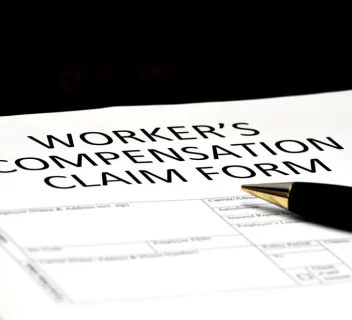Report Accident at Work: Your Complete Legal Guide to Protecting Your Rights
Introduction: What is Workplace Accident Reporting and Why It Matters for Your Legal Case
Reporting an accident at work is a critical legal step that protects your right to workers’ compensation benefits and potential personal injury claims. When an incident occurs at your workplace, how you handle the accident reporting process can make or break your case and determine whether you receive thousands of dollars in compensation or nothing at all.
This comprehensive guide explains how proper workplace accident reporting safeguards your legal interests and how 1-800-THE-LAW2 can help you navigate the process of connecting to a qualified attorney for assistance. You’ll learn the essential legal requirements, step-by-step reporting procedures, common mistakes that destroy claims, and why experienced legal representation is crucial for maximum compensation.
Whether you’ve suffered a workplace injury requiring medical treatment or witnessed a work-related incident, understanding your rights and the claim process is essential. Don’t let insurance companies or employers minimize your case – protect yourself with the knowledge and legal support you deserve.
Understanding Workplace Accident Reporting: Key Legal Concepts and Definitions
Core Legal Definitions
Workplace accident reporting refers to the formal legal process of documenting work-related injuries or incidents to protect your rights under workers’ compensation laws and maintain eligibility for benefits. This process involves multiple types of reports that serve different legal purposes:
- Incident Report: Internal company documentation of workplace injuries or accidents
- OSHA Report: Federal reporting required for serious injuries, including patient hospitalization, amputation, or eye loss
- Workers’ Compensation Claim: Formal request for benefits covering medical care, lost wages, and rehabilitation
- Employer’s Report: Official documentation submitted by employers to insurance carriers and state agencies
Understanding these distinctions is crucial because each type of report serves different legal functions and has specific deadlines that can affect your compensation.
Legal Framework and Your Rights
Federal OSHA requirements and state workers’ compensation laws create a comprehensive framework protecting injured workers. When you report injuries, you trigger multiple legal protections:
- OSHA Jurisdiction: Requires employers to maintain safe workplaces and report serious incidents to federal authorities within eight hours for fatalities and 24 hours for hospitalizations
- Workers’ Compensation Laws: State-specific systems providing medical treatment coverage and wage replacement regardless of fault
- Anti-Retaliation Protections: Legal safeguards preventing employers from punishing workers who report workplace injuries
Proper accident reporting also preserves your right to pursue third-party liability claims against equipment manufacturers, contractors, or other parties whose negligence contributed to your injury or illness.
Why Proper Accident Reporting is Critical for Your Legal Case
Timely workplace accident reporting is the foundation of every successful workers’ compensation claim and personal injury lawsuit. Reporting workplace injuries that occur on the job is essential for legal protection. The legal and financial stakes are significant:
Financial Protection: Workers who immediately report workplace injuries and seek medical attention are 85% more likely to receive full workers’ compensation benefits, which can total hundreds of thousands of dollars for serious injuries requiring ongoing medical care and rehabilitation.
Evidence Preservation: Prompt reporting ensures crucial evidence is documented before it’s lost, altered, or destroyed. This includes witness statements, equipment conditions, and physical evidence at the accident scene. Documentation should also include details about the injured person to ensure proper follow-up and legal compliance. Thorough reporting and investigation help identify root causes and implement corrective actions to prevent recurrence of similar incidents.
Legal Deadlines: Most states require injured workers to report workplace incidents within 30 days to maintain eligibility for workers’ compensation benefits. Missing these deadlines can permanently bar your claim, leaving you responsible for all medical treatment costs and lost wages.
Third-Party Claims: Proper documentation of accident causes and investigating accidents thoroughly can reveal additional parties whose negligence contributed to your workplace injury, potentially leading to substantial personal injury settlements beyond workers’ compensation.
Critical Reporting Deadlines and Legal Requirements Table
| State Requirement | Deadline | Consequence of Missing Deadline |
|---|---|---|
| Notify Employer Verbally | Immediately or within 24 hours | May impact claim credibility |
| Written Notice to Employer | 30 days (varies by state) | Can completely bar workers’ comp claim if not reported promptly |
| OSHA Reporting (Serious Injuries) | 8-24 hours | Federal penalties for employers if work-related hospitalization, amputation, or eye loss is not reported within the required timeframe |
| Workers Compensation Filing | 1-2 years (varies by state) | Permanent loss of benefits |
| Personal Injury Lawsuit | 2-3 years (statute of limitations) | Cannot pursue additional compensation |
Critical Note: These deadlines vary significantly by state and injury type. Work-related hospitalization, amputation, or eye loss must be reported to OSHA within the required timeframe to comply with federal law. Contact 1-800-THE-LAW2 immediately to connect to a qualified attorney in our network. An attorney is required by law (once they take you on as a client) to help you meet all applicable deadlines for your specific situation.
Employer’s Responsibilities: What Your Company Must Do After an Accident
When a workplace accident occurs, employers have a legal and ethical duty to act swiftly and responsibly to protect the injured worker and ensure compliance with occupational safety and workers’ compensation laws. The actions taken in the immediate aftermath of a work-related incident can significantly impact the outcome of a workers’ compensation claim and the overall safety and health of the workplace.
Immediate Response and Medical Care: As soon as an incident occurs, employers must prioritize the well-being of the injured employee by providing prompt medical attention. This may include administering first aid on site and arranging for further medical treatment or inpatient hospitalization if necessary. Ensuring the injured worker receives appropriate medical care not only supports their recovery but also creates essential documentation for the claim process.
Timely and Accurate Reporting: Employers are required to report injuries and illnesses according to strict reporting requirements. For incidents resulting in a fatality, inpatient hospitalization, amputation, or loss of an eye, employers must notify OSHA within eight hours. This obligation applies to all employers under OSHA jurisdiction, regardless of company size or industry. In addition to notifying OSHA, employers must complete a detailed incident report and submit an employer’s report to their workers’ compensation carrier and relevant state agencies. These accident reports should include the date, time, and location of the incident, a description of the injuries, and the names of all employees involved.
Initiating the Claim Process: After a workplace accident, employers must initiate the workers’ compensation claim process by providing the injured employee with the necessary forms and information. This includes explaining the steps for filing a workers’ compensation claim and ensuring all required documentation is completed and submitted promptly. Employers must also cooperate with insurance carriers and state agencies throughout the investigation and resolution of the claim.
Investigating Accidents and Preventing Recurrence: A thorough investigation into the root cause of the accident is essential for risk management and future prevention. Employers should analyze accident reports, interview witnesses, and review workplace conditions to identify areas where safety improvements are needed. Implementing corrective actions and updating safety protocols can help prevent similar incidents resulting in workplace injuries or illnesses.
Ongoing Safety and Training: Employers are responsible for maintaining a safe working environment by regularly identifying potential hazards and providing safety training to all employees. Establishing specific procedures for reporting work-related incidents and ensuring that all staff are aware of these protocols is crucial for compliance and effective risk management.
By fulfilling these responsibilities—providing immediate medical care, accurately reporting incidents, investigating accidents, and prioritizing occupational safety—employers not only comply with workers’ compensation laws and OSHA regulations but also foster a culture of safety and health in the workplace. Taking these proactive steps helps protect both employees and the organization from the consequences of workplace accidents and ensures a safer, more productive work environment for everyone.
Step-by-Step Legal Guide to Reporting Your Workplace Accident
Step 1: Ensure Immediate Safety and Seek Medical Care
Your health and legal protection start with immediate medical attention. Even if your workplace injury seems minor, seeking prompt medical care serves two crucial purposes:
- Health Protection: Some work-related injuries worsen without immediate treatment
- Legal Documentation: Medical records create official evidence linking your injury to the workplace incident
Document all medical treatment received, including emergency room visits, diagnostic tests, and prescribed medications. Keep detailed records of all medical care providers and retain copies of all medical reports and bills.
Step 2: Report to Your Employer Within Legal Deadlines
Notify your employer about the workplace accident immediately, both verbally and in writing. Use specific language clearly stating the incident was work-related and occurred during the course of employment.
Essential Reporting Elements:
- Date, time, and location of the incident
- Detailed description of how the accident occurred
- Body parts injured and symptoms experienced
- Names of witnesses present
- Equipment or hazards involved
Request a copy of your employer’s incident report and review it carefully for accuracy. Any errors in the initial accident reports can be used against you later by insurance companies.
Step 3: Document Everything for Legal Protection
Comprehensive documentation strengthens your workers’ compensation claim and preserves evidence for potential personal injury lawsuits:
- Photographic Evidence: Take pictures of the accident scene, your injuries, and any defective equipment or potential hazards
- Witness Information: Collect contact details and written statements from anyone who saw the incident occur. Be sure to document the name and contact information of every person involved in the incident, not just witnesses.
- Communication Records: Keep detailed logs of all conversations with employers, supervisors, and insurance representatives
This documentation becomes crucial during the investigation process and helps identify areas where employer negligence or third-party liability may have contributed to your workplace injury.
Step 4: Contact 1-800-THE-LAW2 for Legal Representation
Insurance companies have teams of lawyers working to minimize your claim from day one. Level the playing field by contacting 1-800-THE-LAW2 immediately to connect with a qualified attorney. You’ll have access to:
- Free Case Evaluation: Experienced workplace injury attorneys can review your case for maximum compensation opportunities
- Deadline Protection: If you sign on with an attorney as a client, the attorney will ensure all legal requirements and reporting deadlines are met properly
- Navigating the Complexities of an Insurance Company’s Defense Strategy: Professional legal representation prevents insurance adjusters from using your statements against you
- Fighting for Maximum Compensation: Expert attorneys identify all available sources of compensation beyond basic workers’ compensation
Don’t navigate this complex legal process alone – get the experienced legal advocacy you need to protect your rights and maximize your recovery.
Common Legal Mistakes That Can Destroy Your Case
Mistake 1: Delaying Medical Treatment
Waiting to seek medical care weakens the legal connection between your workplace and your injury. Insurance companies argue that delayed treatment indicates the injury wasn’t serious or work-related.
Mistake 2: Failing to Report in Writing Within State Deadlines
Verbal notification isn’t enough – most states require written notice within 30 days. Missing this deadline can completely bar your workers’ compensation claim, regardless of how severe your workplace injury.
Mistake 3: Accepting Employer’s Initial Accident Report Without Review
Many employer incident reports contain inaccuracies or minimize the severity of workplace injuries. These reports become part of your permanent claim file and can be used against you.
Mistake 4: Speaking to Insurance Adjusters Without Legal Representation
Insurance companies train adjusters to obtain statements that minimize claim values. Anything you say can be taken out of context and used to deny or reduce your benefits.
Pro Tip: Contact 1-800-THE-LAW2 immediately after your workplace accident to avoid these costly legal errors. We’ll get you connected to an attorney in our network who can potentially help. The experienced attorneys in our network have the skills and training necessary to guide you through each step of the process to protect your rights and maximize your compensation.
Real-Life Case Study: How Proper Reporting Led to Maximum Compensation
Case Study: Construction worker John suffered a serious workplace injury when defective scaffolding collapsed, requiring immediate hospitalization and resulting in permanent disability.
Starting Situation:
- Severe back injury requiring surgery and ongoing medical treatment
- Unable to return to work in the construction industry
- Employer’s insurance initially offered only basic workers’ compensation benefits totaling $45,000
Steps Taken after Connecting with an Attorney:
- Immediate medical documentation and proper employer notification
- Thorough investigation revealed defective equipment from a third-party manufacturer
- Comprehensive evidence collection, including witness statements and expert analysis
- Legal team pursued both workers’ compensation and product liability claims
Final Results:
- Full workers’ compensation benefits: $125,000
- Third-party settlement against equipment manufacturer: $675,000
- Total Recovery: $800,000 vs. initial $45,000 offer
This case demonstrates how proper workplace accident reporting combined with experienced legal representation can increase compensation by more than 1,700%. The key was identifying multiple sources of liability and pursuing all available legal remedies.
Frequently Asked Questions About Workplace Accident Reporting and Your Legal Rights
A1: Employer retaliation for reporting workplace injuries is illegal under federal and state laws. Contact 1-800-THE-LAW2 immediately – our attorneys protect workers from employer intimidation and ensure your rights are preserved while pursuing all available compensation.
A2: Possibly, but time is critical. State reporting requirements vary from 30 days to 2 years, depending on the injury type and jurisdiction. Call 1-800-THE-LAW2 now to connect to an attorney for a free case evaluation to determine your options and protect any remaining rights.
A3: Workers’ compensation covers medical bills and lost wages regardless of fault, while personal injury claims can provide additional compensation if third parties like equipment manufacturers, contractors, or other companies contributed to your workplace accident through negligence.
A4: Insurance companies have teams of lawyers and adjusters working to minimize every claim, regardless of size. Even “simple” workplace injuries can involve complex legal issues, hidden deadlines, and opportunities for additional compensation that only experienced attorneys can identify and pursue.
Conclusion: Protect Your Rights with Proper Reporting and Legal Representation
Workplace accident reporting is your first line of defense in protecting your legal rights and financial future after a work-related injury. Remember these five critical points:
- Seek immediate medical attention to protect your health and create essential legal documentation
- Report promptly to your employer both verbally and in writing within the state deadlines
- Document thoroughly with photos, witness statements, and detailed records
- Avoid insurance company traps by having legal representation before speaking with adjusters
- Get experienced legal help to identify all sources of compensation and maximize your recovery
Proper reporting is just the first step in protecting your rights. Maximum compensation requires experienced legal representation that understands workers’ compensation laws, OSHA requirements, and personal injury litigation.
Don’t let insurance companies minimize your claim. Call 1-800-THE-LAW2 now for a free consultation. The experienced workplace injury attorneys in our network are standing by ready to fight for the compensation you deserve.
Time is critical – contact us today. Attorneys help ensure your rights are protected and that your claim is handled properly from the very beginning.




